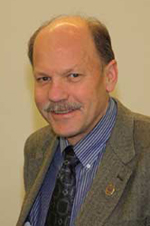March 2012

Nicholas S. Hill, MD
Those of us specializing in pulmonary, critical care, and sleep medicine are suffering from a public attention deficit disorder. By this I mean that public awareness of the diseases we treat is disproportionately low compared to the morbidity, mortality, and costs attributable to these diseases.
Examples of this abound. Chronic lung diseases, mainly COPD, recently assumed the dubious distinction of being the third-leading cause of death worldwide and cost untold billions of dollars in lost productivity and consumption of healthcare resources. And yet, a 2008New York Times Magazine article on health featured an illustration of the internal organs that omitted the lungs. Cancer is the leading cause of death worldwide and in the United States, and lung cancer is the leading cause of cancer death for both men and women. And yet lung cancer research funding is below that of a number of other cancers. Critical care medicine in the United States accounts for an estimated 4.2 percent of national health expenditures and about 13 percent of hospital costs. And yet, research funding for critical care amounts to less that 1 percent of the National Institutes of Health annual budget. Lack of public awareness leads to underfunding of research and care for the diseases we face, and stymies progress in combating them.
What has the ATS been doing about this problem? The ATS has long been a strong advocate for increasing public awareness and greater investment in care and research for the diseases we treat. Our Washington Office tracks trends and opportunities in the federal government and organizes our commentaries and lobbying efforts in response to proposed legislation and initiatives. Each year, our leadership participates in Hill Day, when we visit legislators and their staff members to advocate for more research funding and relevant healthcare initiatives. We partner with members of our Public Advisory Roundtable in these efforts, greatly bolstering our efforts by adding the voices of our patients.
In recent years, we have also published the book, Breathing in America, edited by immediate past president Dean Schraufnagel and co-sponsored by the National Heart, Lung, and Blood Institute, which serves as an advocacy tool aimed at educating the public and legislators about the range of pulmonary, critical, and sleep disorders, the progress that has been made in treating them, and the acute need for more research. We have also partnered with the Forum of International Respiratory Societies (FIRS) on the Year of the Lung (2010). With the help of a public relations firm, Year of the Lung increased awareness of lung diseases via legislation, press releases, and a variety of events including World Spirometry Day, first held on October 14, 2010. Over 100,000 spirometries were performed worldwide, but only about 5 percent of them in North America.
Clearly, these efforts, although laudatory, amount to nibbling away at the problem and much more needs to be done. Once again, FIRS is organizing a World Spirometry Day to be held on June 27, 2012, designed to increase awareness of lung health and diseases via local events that are to generate public awareness via local press releases and advertising. This is to be tied to publicity surrounding the London Olympics and events need not be held on June 27 alone, but can be continued on through and beyond the Olympic events in July. We want to do even better than in 2010 and are encouraging all institutions, practices, and PFT labs to participate and work with their hospital public relations departments to use the World Spirometry Day to promote and publicize lung health and its association with physical fitness.
The World Spirometry Day website can be accessed via the link: http://www.wsd2012.european-lung-foundation.org/ or by searching for “world spirometry day” via Google or the ATS website. A toolkit is available on the website with all the materials needed to set up a spirometry site.
Increasing advocacy efforts among our members in collaboration with PAR groups is also one of my aims as President. I have been working with members of my Presidential Commission on Patient Involvement, Nuala Moore of our Washington Office and members of our Chapter of Council Representatives to initiate a grassroots advocacy effort which is aimed at complementing our Hill Day visits in DC. The idea is to target key legislators locally when they visit their districts. Via our chapters and PAR groups, we would arrange face-to-face visits with legislators who would hear not only from interested ATS members, but also from patients, and our hope is that the combined voices would deliver a louder and clearer message.
All ATS members can play a role in these efforts. When we advocate for healthy lifestyles when seeing our patients or give talks on health at local schools (as I did when my children were young) or support smoke-free efforts in our hospitals, towns, and cities, or participate in World Spirometry Day or visit legislators, we are helping. We must be relentless, though, partly because we are still too often battling the perception that lung disease patients “did it to themselves” by smoking.

